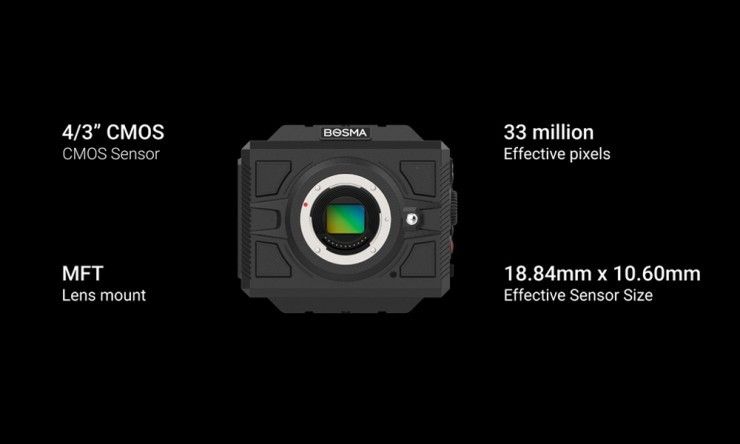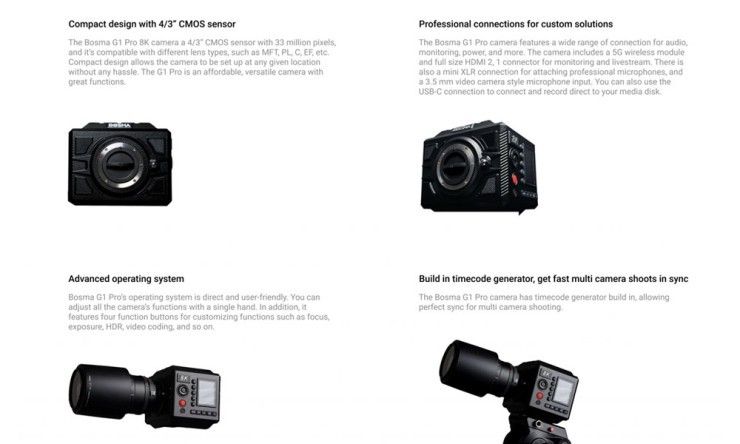
The Bosma G1 Pro 8K camera is here. But who is this 8K camera for?
Bosma has made a name for itself selling home security cameras, video doorbells, and other products designed to keep the home safe and secure. Now the company is expanding into more creative endeavors with its Bosma G1 Pro 8K Camera.
But in a world where resolution is no longer king and image fidelity is the next frontier, is this new camera a little too late to the market? With the new Sony FX30, the Fujifilm X-H2S, and the RED DSMC3 line making waves in the past few months, what will Bosma bring to the table to make sure its new camera gives creatives an edge?
The Bosma G1 Pro 8K
Marketed as an affordable 8K camera for YouTube content creators and streamers, the Bosma G1 Pro 8K has had a lengthy development process that culminated in a trial run last year at the 2022 Winter Olympics in Beijing.
The G1 Pro has a 33 MP 4/3” CMOS image sensor capable of capturing 8K 12-bit HDR video at 30 frames per second with a bit rate of 600 Mbps in H.265 or H.264. The camera also supports 4K video at 60 frames per second with a bit-rate of 150 Mbps and full HD video at 60p.

The camera has an ISO setting range of 250 to 25600, a global shutter control from 1° to 360°, and a Hybrid Log Gamma/HDR 10 color while utilizing the BT.7.9 or BT.2020 color space. For dynamic range, Bosma is stating 11 stops. This brings us to our first hurdle. Modern cameras offer several stops more as a standard.
The G1 Pro also uses a Micro Four-Thirds lens mount, and the company says there are compatible lens mounts for PL, C, Canon EF, and other lens options, presumably through a lens adapter.
Video encoding options include ProRes 422 with options including 422 Proxy, 422 LT, and 422 HQ (pending certifications). Until then, users can rely on H.264 in 8-bit 4:2:0 and H.265 in 10-bit 4:2:0. For audio, the Bosma G1 Pro includes 24-bit 48KHz audio encoded in AAC or PCM audio streams.

For connections, the camera offers 2.4GHz with support for 5GHz Wi-Fi through an antenna module, support for 5G cellular live-streaming in 4K, HDMI 2.1, Genlock, Timecode in/out, a mini XLR mic connection, 3.5mm Minijack in, Type-C USB for recording to an external hard drive, and Ethernet.
Storage uses CFast 2.0 or External SSD via USB Type-C and supports camera-to-cloud applications through Wi-Fi or cellular connections. Power to the camera comes from 12 VDC via a 2-pin LEMO connector or an L-series battery.

The control interface is pretty simple, with four customizable function buttons for customizing focus, exposure, HDR, video codecs, and other preferred settings. There is also a red record button, fast-forward and rewind controls, power, and a function wheel for navigating the LCD menu screen display.
The camera weighs 1250g, and is compact and lightweight enough to be mounted to a higher-end drone like the DJI M600 or M300.
Who Is This Camera For?
All told, the Bosma G1 Pro seems to be aimed squarely at content creators looking to take the next step and move up from a DSLR or mirrorless camera. However, content creators who are streaming won't need the kind of resolution that the Bosma G1 Pro is pumping out. Even if you're uploading to YouTube, shooting 8K is like taking a spaceship to work when you actually only need an Uber.
Some news outlets are stating that the Bosma G1 Pro is a cinema camera, but we were hard-pressed to find any mention of that term in its marketing material. Even if it was built for cinema applications, the competition in the cinema camera space is fierce. What the Bosma G1 Pro is offering, unfortunately, wouldn't be able to compete.
The Bosma G1 Pro is available now for $3499, and it comes with the G1 Pro 8K camera body, two Wi-Fi antennas, and a power adapter. Sadly, with how long it took to come to market, it's no longer the most affordable 8K camera available. That title belongs to the Fujifilm X-H2.
What do you think of the Bosma G1 Pro? How would you use this tool? Let us know in the comments!
Your Comment